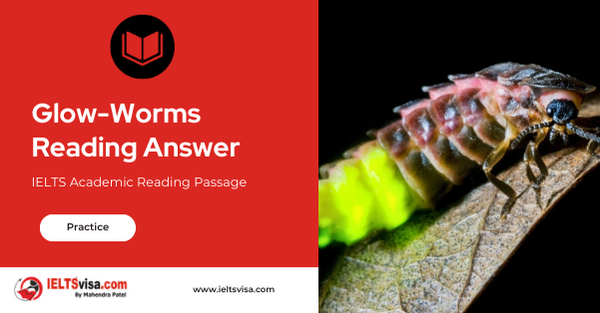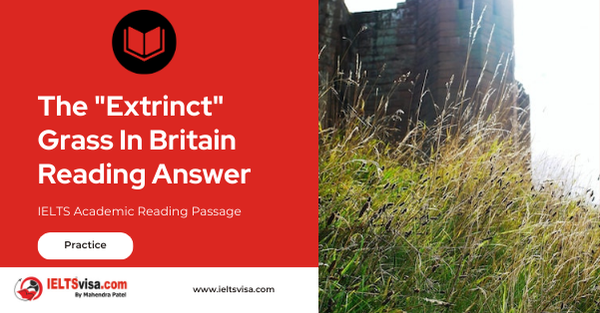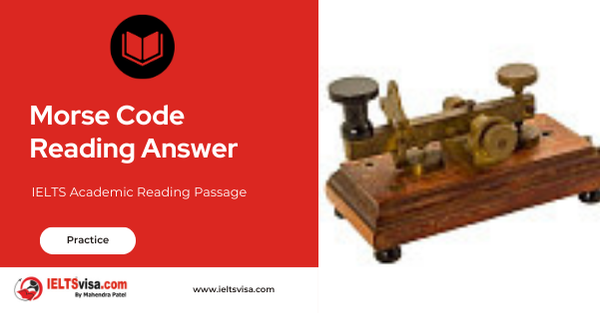Glow-Worms Reading Answer
IELTS Academic Reading Passage
A
The glow-worm belongs to a family of beetles known as the Lampyridae or fireflies. The fireflies are a huge group containing over 2000 species, with new ones being discovered all the time. The feature which makes fireflies and glow-worms so appealing is their ability to produce an often dazzling display of light. The light is used by the adult fireflies as a signal to attract a mate, and each species must develop its own ‘call-sign’ to avoid being confused with other species glowing nearby. So within any one area each species will differ from its neighbours in some way, for example in the colour or pattern of its light, how long the pulses of light last, the interval between pulses and whether it displays in flight or from the ground.
B
The firefly’s almost magical light has attracted human attention for generations. It is described in an ancient Chinese encyclopaedia written over 2000 years ago by a pupil of Confucius. Fireflies often featured in Japanese and Arabian folk medicine. All over the world they have been the inspiration for countless poems, paintings and stories. In Britain, for example, there are plenty of anecdotes describing how glow-worms have been used to read by or used as emergency bicycle lamps when a cyclist’s batteries have failed without warning. Early travellers in the New World came back with similar stories, of how the native people of Central America would collect a type of click beetle and release them indoors to light up their huts. Girls threaded them around their feet to illuminate the forest paths at night.
Fireflies very similar to those we see today have been found fossilised in rocks which were formed about 30 million years ago, and their ancestors were probably glowing long before then. It is impossible to be sure exactly when and where the first firefly appeared. The highest concentrations of firefly species today are to be found in the tropics of South America, which may mean either that this is where they first evolved, or simply that they prefer the conditions there.
Wherever they first arose, fireflies have since spread to almost every part of the globe. Today members of the firefly family can be found almost anywhere outside the Arctic and Antarctic circles.
C
As with many insects, the glow-worm’s life is divided into four distinct stages: the egg, the larva (equivalent to the caterpillar of a butterfly), the pupa (or chrysalis) and the adult. The glow-worm begins its life in the autumn as a pale yellow egg. The freshly laid egg is extremely fragile but within a day its surface has hardened into a shell. The egg usually takes about 35 days to hatch, but the exact time varies according to the temperature, from about 27 days in hot weather to more than 45 days in cold weather. By the time it is due to hatch, the glow-worm’s light organ is fully developed, and its glow signals that the egg will soon hatch.
After it has left the egg, the larva slowly grows from a few millimetres into the size and shape of a matchstick. The larval stage is the only time the insect can feed. The larva devotes much of its life to feeding and building up its food reserves so that as an adult it will
be free to concentrate all its efforts on the task of finding a mate and reproducing. Throughout its time as a larva, approximately 15 months, the glow-worm emits a bright light. The larva’s light is much fainter than the adult female’s but it can still be seen more than five metres away.
In the final stage of a glow-worm’s life, the larva encases itself in a pupa) skin while it changes from the simple larva to the more complex adult fly. When the adult fly emerges from the pupa the male seeks a female with whom it can mate. After mating, the female lays about 120 eggs. The adult flies have no mouth parts, cannot eat and therefore only live a few days. When people talk of seeing a glow-worm they normally mean the brightly glowing adult female.
D
In some countries the numbers of glow-worms have been falling. Evidence suggests that there has been a steady decrease in the British glow-worm population since the 1950s and possibly before that. Possible causes for the decline include habitat destruction, pollution and changes in climate. Thousands of acres of grassland have been built upon and glow- worm sites have become increasingly isolated from each other. The widespread use of pesticides and fertilisers may also have endangered the glow-worm. Being at the top of a food chain it is likely to absorb any pollutants eaten by the snails on which it feeds. The effect of global warming on rainfall and other weather patterns may also be playing a part in the disappearance of glow-worms. A lot more research will be needed, however, before the causes of the glow-worm’s gradual decline are clear.
E
Although glow-worms are found wherever conditions are damp, food is in good supply and there is an over-hanging wall, they are most spectacular in caves. For more than 100 years the glow-worm caves in New Zealand have attracted millions of people from all over the world. The caves were first explored in 1887 by a local Maori chief, Tane Tinorau, and an English surveyor, Fred Mace. They built a raft and, with candles as their only light, they floated into the cave where the stream goes underground. As their eyes adjusted to the darkness they saw myriad lights reflecting off the water. Looking up they discovered that the ceiling was dotted with the lights of thousands of glow-worms. They returned many times to explore further, and on an independent trip Tane discovered the upper level of the cave and an easier access. The authorities were advised and government surveyors mapped the caves. By 1888 Tane Tinorau had opened the cave to tourists.
Questions 1-6
The reading passage has five sections labelled A-E. Which section contains the following information?
Write the correct letter A-E in boxes 1-6 on your answer sheet.
NB You may use any letter more than once.
1. threats to the glow-worm
2. ways in which glow-worms have been used
3. variations in type of glow-worm
4. glow-worm distribution
5. glow-worms becoming an attraction
6. the life-cycle of a glow-worm
Questions 7-13
Do the following statements agree with the information given in the reading passage.
In boxes 7-13 on your answer sheet, write
TRUE if the statement agrees with the information
FALSE if the statement contradicts the information
NOT GIVEN if there is no information on this
7. Scientists have only recently been able to list the exact number of glow- worm species.
8. The first fireflies appeared 30 million years ago.
9. Glow-worm populations are decreasing faster in some countries than in others.
10. Heat affects the production of glow-worm larvae.
11. Adulthood is the longest stage of a glow-worm’s larvae.
12. The exact reason why glow-worm numbers are decreasing is unknown.
13. Glow-worms are usually found in wet areas.

Solution for: Glow-Worms Reading Answer
| 1. D | 8. FALSE |
| 2. B | 9. NOT GIVEN |
| 3. A | 10. TRUE |
| 4. B | 11. FALSE |
| 5. E | 12. TRUE |
| 6. C | 13. TRUE |
| 7. NOT GIVEN |
Review and Practice
- Regularly practice with IELTS reading samples and time yourself to get used to the pressure of the exam.
- Review your mistakes to understand where you went wrong and how to avoid similar errors in the future.
Our Books
Master IELTS Speaking Part 1
IELTS Writing Task 1 Book
IELTS Writing Task 2 Book
Glow-Worms Reading Answer Explanation
Comin Soon
Practice IELTS Other Modules
IELTS Listening
The IELTS Listening test assesses how well you can understand spoken English in various contexts. It lasts about 30 minutes and is divided into four sections with a total of 40 questions. The listening tasks become increasingly difficult as the test progresses.
IELTS Academic Reading
The IELTS Academic Reading section assesses your ability to understand and interpret a variety of texts in academic settings. It is designed to evaluate a range of reading skills, including skimming for gist, reading for main ideas, reading for detail, understanding inferences, and recognizing a writer's opinions and arguments.
IELTS Speaking
The IELTS Speaking test assesses your ability to communicate in English on everyday topics. It lasts 11-14 minutes and consists of three parts: introduction, cue card, and a discussion based on the cue card topic.
IELTS General Reading
IELTS General Reading tests your ability to understand and interpret various types of texts. Here are some key areas and types of content you can expect to encounter in the reading section, along with tips for effective preparation.
IELTS Academic Writing Task 1
In IELTS Academic Writing Task 1, you are presented with a visual representation of information, such as graphs, charts, tables, or diagrams, and you are required to summarize, compare, or explain the data in your own words.
IELTS General Writing Task 1
In IELTS General Writing Task 1, you are required to write a letter based on a given situation. The letter can be formal, semi-formal, or informal, depending on the prompt. Here’s a breakdown of the key components to include in your letter
IELTS Academic Writing Task 2
In IELTS Academic Writing Task 2, you are required to write an essay in response to a question or topic. Here’s a guide to help you understand the essential elements of this task
IELTS Exam Tips
To succeed in the IELTS exam, practice regularly, familiarize yourself with the test format, improve your vocabulary, develop time management skills, and take mock tests to build confidence.
Grammer for IELTS
Grammar is the foundation of effective communication in English. Understanding tense usage, subject-verb agreement, and sentence structure enhances clarity and coherence in writing and speaking.
Vocabulary for IELTS
Vocabulary plays a crucial role in the IELTS (International English Language Testing System) exam, especially in the Speaking and Writing sections. Here’s an overview of why vocabulary is important and how it impacts your performance
RECENT IELTS SAMPLES QUESTIONS AND ANSWERS
The Life And work Of Marie Curie Reading Answer
Marie Curie is probably the most famous woman scientist who has ever lived. Born Maria...
Becoming An Expert Reading Answer
A Expertise is commitment coupled with creativity. Specifically, it is the commitment of...
STUDY CENTRE COURSES Reading Answer
SELF-STUDY TIPS AHowever difficult you find it to arrange your time, it will pay off in the...
The Extrinct Grass In Britain Reading Answer
A The British grass interrupted brome was said to be extinct, just like the Dodo. Called...
Morse Code Reading Answer
A. A new satellite-based system is being implemented to replace Morse code for sending...
Magnetic Therapy Reading Answer
AMagnetic therapy, which is a $5-billion market worldwide, is a form of alternative medicine...













